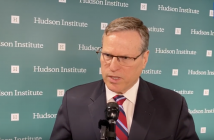Read the Report – Since the September 11, 2001, attacks, the U.S. government (USG) has used security assistance programs with partner nations to advance its counterterrorism (CT) objectives. These programs serve two main purposes: first, to build the capacity of partners, who are best positioned to address local security and governance challenges; and second, to incentivize actions in these areas and others that advance U.S. counterterrorism interests. The rationale underpinning this approach is that partners are not only best positioned to address certain security challenges, but also that burden sharing is essential if the United States is to avoid the type of overreach that can dilute its political and military power. Thus, these programs, although expensive, are intended to defray costs away from the United States, which learned from the Iraq and Afghanistan experiences that a counterterrorism strategy centered on a heavy American footprint is costly and politically unsustainable.
Despite the proliferation of security assistance authorities and programs, the U.S. government has only recently begun to mature the joint planning and evaluation processes that many agree should drive such programming. For example, security assistance implementing agencies have just begun to wrestle with developing monitoring and evaluation mechanisms for measuring the effectiveness of CT-related security assistance. There are no standard guidelines for determining the goals of CT security assistance programs, particularly partner capacity-building training programs, or for assessing how these programs fit into broader U.S. foreign policy objectives. And there are few metrics for measuring the effectiveness of these programs once they are being implemented.
Drawing upon field research in two recipient nations of U.S. CT security assistance – Jordan and Kenya – as well as interviews and workshops with U.S. government officials and nongovernmental experts, this study attempts to address some of these challenges. The research leads to three central conclusions:
U.S. CT security assistance should devote more programming, resources, time, and effort to improving the capacity of law enforcement and internal security instead of focusing almost exclusively on building military CT capabilities for partner nations.
In both Kenya and Jordan, the overwhelming preponderance of U.S. CT security assistance goes toward addressing external threats posed by the Islamic State of Iraq and al-Sham (ISIS) and al-Shabaab, respectively. The threats from these groups also manifest inside these countries as a result of the radicalization of vulnerable populations. Yet considerably less energy and fewer resources are focused on ensuring that the internal security services in Jordan and Kenya address such threats effectively, or protect and do not marginalize or alienate vulnerable populations. The United States’ recent increased emphasis on countering violent extremism (CVE) at the local level is a welcome step, but it is critical that implementation of this strategy is paired with other programs intended to buttress partners’ internal security and improve the behavior of their security services. Such efforts should include programs intended to build the institutional capacity of partners’ ministries of the interior, professionalize personnel, and improve their ability to conduct planning and coordination. The United States does not need to reinvent the wheel. There is much to learn from other international donors and local nongovernmental organizations (NGOs) that are already working in this space.
The USG should develop a common standard for metrics throughout the interagency to ensure CT security assistance programs are monitored and evaluated based on outcomes, not just inputs and outputs.
The State Department’s (DoS) current protocol for assessment, monitoring, and evaluation (AM&E) is overly decentralized, and other agencies have yet to develop robust AM&E programs. Efforts underway at the Department of Defense (DoD) to develop a systemic protocol for assessment, monitoring, and evaluation of security assistance programs represent a step in the right direction, but it will be important to ensure this program is interoperable with others in the interagency. The first step is ensuring that every agency involved in CT security assistance has a functional AM&E program in place. As it institutes these systems, the USG should ensure that departments are sharing best practices and lessons learned with one another and also mining the knowledge of local nongovernmental project implementers, who often have the greatest experience dealing with the issue of measurement. To support this effort, a larger share of the security assistance budget should be dedicated to monitoring and evaluation. The internationally accepted best practice is to devote 3 percent to 5 percent of any program budget to AM&E.
Efforts to develop better AM&E protocols must recognize that this process is not something that begins once a program has been implemented or completed.
Effective AM&E starts during the planning process. All programs must be guided by clearly delineated objectives that are specific, measurable, and achievable within an identified time frame. Moreover, any program should illustrate how achieving these objectives will advance wider U.S. counterterrorism goals, how they align with other relevant USG programs, and how they may complement or conflict with broader USG policy objectives. Some problems may be insurmountable, and this makes being upfront about the theory of change even more important in order to avoid squandering limited resources, time, attention, and political capital. Articulating the theory of change at the outset and the time scale necessary to execute it, is also critical for overcoming the tendency to focus heavily on near-term objectives that are more easily measured than on long-term reforms that might be more consequential. In cases where it might take years to realize a major return on investment, identifying milestones along the way provides a mechanism for measuring progress and ensuring the program remains on track.




